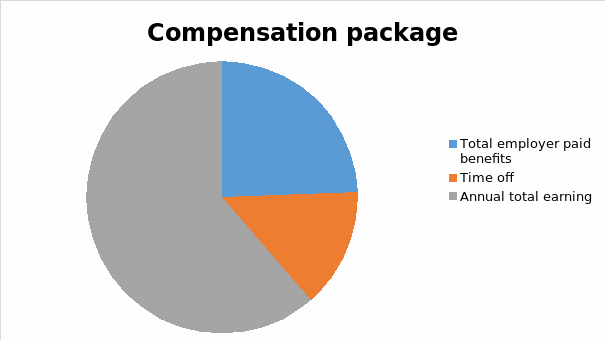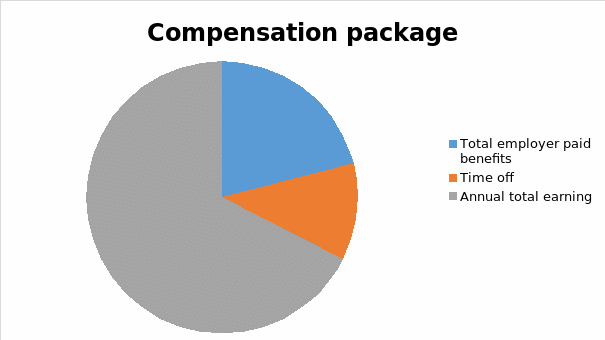- Introduction
- Interview of Two Employees
- Mrs. Jane Mathews: National Bank of Canada
- Mr. John Smart: Nesbitt Thomson and Company
- Comparison of the full-value of the two total rewards plans
- Behaviours that each major group of compensation choices should inspire
- Impacting employee behaviour through the compensation structures
- Components with the most impact on behaviours
- Personal reflection
- Conclusion
Introduction
The need for a strategic compensation plan, as a form of promoting quality and productivity, has made companies across the global village to adopt different incentive plans to give employees an array of benefits. Often, these plans are aimed at enticing the workforce to perform above the normal standards. To increase productive behaviour for all employees, it is vital to create a healthy work environment and personal growth perspectives that apply to all situations.
Labour efficiency is a critical element in optimal performance in any organisational environment. Among the merits of incentive plans include minimisation of envy between employees, acquisition of different learning skills from several interacting teams, and collective responsibility in the execution of duties. This analytical treatise will present comprehensive reward statements for two employees working at the Nesbitt and Thomson Company and the National Bank of Canada respectively. These companies are based in Montreal.
Interview of Two Employees
In order to gather data on the reward choices and employee benefits, I interviewed Mr. John Smart, who is an accountant at the Nesbitt and Thomson Company, and Mrs. Jane Mathews, who is also an accountant at the National Bank of Canada. The two employees have worked in these institutions for five and seven years respectively. John is thirty two years old while Jane is twenty nine years old. The two employees work on a permanent basis for these organisations. The interviews were aimed at establishing the reward plans for these companies in order to make a clear comparison of the benefits against level of performance between the two employees.
The interviews were designed to capture all the elements of compensation benefits such as time-offs, employer paid benefits, and the total annual compensation. Further the interviews were meant to establish the detailed employer provided benefits and the costs that these organisations incur in order to give these gains. It is important to note that the benefits from the two organisations are compliant with the Canadian government’s labour regulations. The findings are indicated in the tables below.
Mrs. Jane Mathews: National Bank of Canada
(Source: Self generated)
The figures in the table above were analysed and presented in a pie chart to reflect on the variations in percentages among the variables such as total employer paid benefits, time-offs, and total annual earnings. This is summarised in the pie chart below.

Summary of the employer provided benefits
(Soource: Self generated)
Mr. John Smart: Nesbitt Thomson and Company
(Soource: Self generated)
The figures in the table above were analysed and presented in a pie chart to reflect on the variations in percentages among the variables such as total employer paid benefits, time-offs, and total annual earnings. This is summarised in the pie chart below.

Summary of the employer provided benefits
(Soource: Self generated)
Comparison of the full-value of the two total rewards plans
From the interview findings, as indicated in the above tables, the National Bank of Canada has a more attractive reward plan than the Nesbitt and Thomson Company. Jane Mathews, an employee of the National Bank of Canada, has a better employee compensation plan than John. The compensation comprises of attractive packages for day-offs, direct employment benefits, and annual earnings. Specifically, Jane earns a total of $12,000 in the form of employer paid benefits, total annual compensation of $41,160.12, and time-offs valued at $1,500. Generally, Jane has an attractive employer paid benefits that offers health cover, mileage, work compensation, retirement, and disability among others.
On the other hand, John, who is an employee of the Nesbitt and Thomson Company, earns a total of $9,000 in the form of employer paid benefits, total annual compensation of $40,000, and time-offs valued at $1,200. Same as Jane, John has an attractive employer paid benefits that offers health cover, mileage, work compensation, retirement, and disability among others. However, his cumulative benefits are lower than that of Jane despite having the same qualification and working in the same industry.
Behaviours that each major group of compensation choices should inspire
Pay satisfaction is a central element of employee attraction and retention. Pay adequacy and equity are the determinants of pay satisfaction. Equity theory requires employees to be evaluated through comparison of the ratio of their inputs and outputs with the ratio of input and output of other employees. The inputs take different forms, for instance, job contribution, extra role behaviour exhibited by the employee, and personal contributions. Since the pay ratio for the National Bank of Canada is higher than that of the Nesbitt and Thomson Company, the corporate governance structure of bank has a stronger system for promoting the elements such as culture, structure, systems, and strategic alignment.
The compensation plan for the National Bank of Canada inspires optimal performance through job satisfaction since the total annual compensation and different benefits are relatively attractive. Satisfied employee, in terms of pay, may generally perform efficiently and competently. Therefore, the bank can effectively commit to compliance and adoption of standard business practices since the benefits outweighs the cost implications for this employee.
Naturally, human beings would wish for motivation through mutual consent and internalised empowerment and appreciation. Empowerment unleashes plenty of energy and motivation. Reflectively, the motivation and energy aspects of appreciation function simultaneously at micro and macro levels to facilitate optimal functionality or productivity. Empowering the employees will ensure a stable and sustainable win-win situation as employees will be motivated to work without much supervision from the management or their supervisors. Since John’s annual compensation is within the range of Jane’s annual benefits, it is in order to argue that John may indicate the same behaviour as Jane in terms of efficiency and competency.
Impacting employee behaviour through the compensation structures
The above compensation plans refer to the values of a supportive work environment, concrete learning processes, and personal development that reinforce competency. The effective compensation plans, in terms of monetary benefits, offer the motivation to acquire, bond, comprehend, and defend among the employees. It creates an ideal climate for innovation and communication among the employees. Since the variables to be considered include payroll system, line of business, location, and groups of employees, a company with a good compensation plan might benefit from the worker pay-ratio since it may micromanage the efficiency of the labour force.
Besides, the worker pay-ratio will provide a stable system of creating and managing the compensation measure in a company within a dynamic market. Therefore, the corporate governance system in a company may align the payroll to short and long term objective such as employee development.
Components with the most impact on behaviours
Different compensation rewards inspire those who under perform to improve on their service delivery upon witnessing top achievers receiving rewards. For instance, the annual bonus has the most impact on behaviour of the employees. Examples of annual incentive include individual promotion, compensation for meeting individual targets, and rewards for accomplishing special assignments outside the employee’s scope of duties. This type of incentive plan is not restricted to specific situations and may present quantifiable results in the long term. This incentive plan may impact on employee behaviour, especially where performance is measured through an individual output. The individual will strive to earn a better annual benefit since each package is unique to each employee.
Personal reflection
The compensations plans for the two companies made me appreciate these jobs and working environments since they promise attractive compensation and fringe benefits. Job satisfaction is as a result of a systematic and continuous environmental and personality interaction that fosters the right attitude, as indicated in the compensation plans of the National Bank of Canada and the Nesbitt and Thomson Company.
The main components of total compensation include fringe benefit and wage earnings. Fringe benefits are the main part of total compensation as their influence continues to grow over the decades. Among the other fringe benefits include worker’s compensation, unemployment compensation, and social security. Further the fringe benefits are summarised into paid leaves and insurance benefits. In addition, savings and retirement benefits are part of employer paid benefits for employees. Since these companies offer all of the above benefits, their work environments are very competitive.
Conclusion
In implementing the compensational plans, it is vital to consider the attractiveness of the wage payments. This paper presented a comprehensive review the reward choices for two employees working at the Nesbitt and Thomson Company and the National Bank of Canada. Apparently, the National Bank of Canada has better fringe benefit and wage earnings.